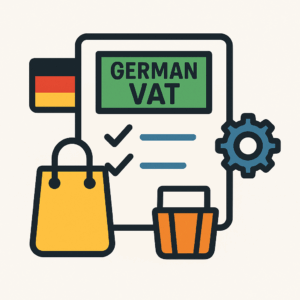German VAT
Value Added Tax (VAT) is one of the most important taxes for businesses active in Germany. It applies broadly to goods and services and is aligned with EU rules. This guide explains the German VAT system, cross-border treatment with the U.S., and practical compliance considerations.
The Value Added Tax (VAT) System in Germany
Germany operates under a Value Added Tax (VAT) system, known in German as Umsatzsteuer. It is one of the most significant sources of public revenue in the country and applies to almost all goods and services supplied domestically, as well as to imports from outside the European Union (EU). Businesses registered in Germany must charge VAT on their taxable supplies and can generally reclaim the VAT they pay on their inputs.
Basic Structure of the German VAT System
The German VAT system follows the principles laid down by the European Union VAT Directive. It is a consumption tax, meaning the final burden falls on the end consumer.
- Standard VAT rate: 19%
- Reduced VAT rate: 7% (applies to specific goods and services, e.g., food, books, cultural services)
- Exemptions: Certain services (such as medical care, financial services, and education) are VAT-exempt.
Input Tax Deduction
Businesses that are VAT-registered can usually deduct the VAT they have paid on purchases (input tax) from the VAT they owe on their sales (output tax). This ensures that VAT is only borne by the final consumer, not by businesses themselves.
Cross-Border Transactions: Germany and the United States
Since the U.S. does not have a federal VAT system but instead relies on sales tax at the state level, transactions between Germany and the United States are subject to special rules.
Import of Goods from the U.S. to Germany
When goods are imported from the United States into Germany, German VAT is generally due upon importation:
- Import VAT is collected by German customs.
- The importer (usually a German company) pays the VAT but can deduct it later as input tax if it is VAT-registered.
- Customs duties may also apply, depending on the type of goods.
Export of Goods from Germany to the U.S.
Exports from Germany to the United States are typically zero-rated for VAT purposes:
- German businesses do not charge VAT on exported goods.
- The exporter must keep proper documentation proving the goods left the EU.
- This ensures that the goods are taxed at their final destination, under U.S. sales tax rules.
Services Between Germany and the U.S.
VAT treatment of services depends on the place of supply rules:
- B2B Services (Business to Business):
If a German company provides services to a U.S. business, the place of supply is usually where the customer is located (the U.S.). Thus, no German VAT is charged. The U.S. recipient may have obligations under local rules. - B2C Services (Business to Consumer):
If services are provided to U.S. private individuals, German VAT may still apply, depending on the type of service (e.g., digital services are often taxed where the consumer is located).
Practical Considerations for Businesses
Documentation and Compliance
Companies engaged in transatlantic trade must maintain accurate invoices, customs declarations, and proof of export to apply the correct VAT treatment.
Double Taxation and Relief
Since the U.S. does not use a VAT system, there is generally no risk of double VAT. However, businesses must be mindful of U.S. state sales tax obligations, which can vary widely.
Professional Guidance
Given the complexity of cross-border transactions, many businesses rely on tax advisors specialized in both German and U.S. regulations to ensure compliance.


